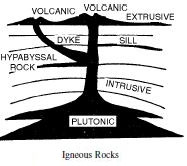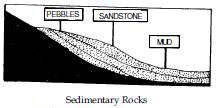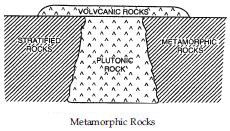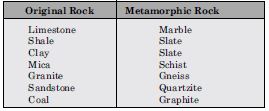Question 1:
Which one of the following are the two main constituents of granite?
- Iron and nickel
- Iron and silver
- Silica and aluminium
- Iron oxide and potassium
Answer:
(c). Silica and aluminium
Question 2:
Which one of the following is the salient feature of metamorphic rocks?
- Changeable
- Quite
- Crystalline
- Foliation
Answer:
(a). Changeable
Question 3:
Which one of the following is not a single element mineral?
- Gold
- Silver
- Mica
- Graphite
Answer:
(c). Graphite
Question 4:
Which one of the following is the hardest mineral?
- Topaz
- Diamond
- Quartz
- Feldspar
Answer:
(a). Feldspar
Question 5:
Which one of the following is not a sedimentary rock?
- Tillite
- Borax
- Breccia
- Marble
Answer:
(d). Marble
Question 6:
What do you mean by rocks? Name the three major classes of rocks.
Answer:
Any natural, solid inorganic or organic material out of which the crust is formed is
called a rock. It may be hard as granite or soft as clay. Clay, chalk, coal, gravel,
etc. are examples of rocks. Lithosphere is made up of rocks. On the basis of their mode
of formation, rocks are divided into three types :
(a) Igneous rocks
(b) Sedimentary rocks
(c) Mentamorphic rocks.
Question 7:
What are the major advantages of the graphical method?
Answer:
It can be used is measure distance on a scale.
Question 8:
What is an Igneous rock? Describe the method of formation and characteristics of Igneous rocks.
Answer:
Igneous Rocks : Igneous rocks are those rocks which have been formed by the cooling and
solidification of molten matter of the earth. Igneous rocks were the first to be formed
on the surface of the earth. Hence, these are also known as Primary Rocks.
Meaning : The word igneous is derived from the Latin word ignis or Sanskrit word ‘Agni’
meaning fire. The interior of the earth is very hot. Rocks are in a molten form and are
called Magma. Thus, igneous rocks are formed by the process of solidification of magma
and granitisation. Thus, igneous rocks are of thermal origin.
Types of Igneous Rocks : On the basis of their situation, igneous rocks are mainly of
two types :
(a) Extrusive Rocks : These rocks are formed when magma solidifies on the surface of the
earth.
(b) Intrusive Rocks : These rocks are formed when magma solidifies beneath the surface
in the crust.
On the basis of the origin and situation, igneous rocks can be divided into three types
:
(1) Volcanic Rocks : These rocks are formed when lava flows out of volcanoes. Lava cools
rapidly and solidifies on the surface of the earth. Due to the rapid cooling of lava,
small crystals are formed. These rocks are glassy in appearance. These rocks have an
aphanatic texture.
Example : Basalt and Gabbro are typical examples. Basalt covers an extensive area of 5
lakh sq. kilometres of N.W. Peninsular India is called Deccan Trap.
(2) Hypabyssal Rocks : Some of the molten matter solidifies in the fissures below the
surface of the earth. These rocks are called Hypabyssal rocks. These fall midway between
Volcanic rocks and Plutonic rocks. These are also termed as Intermediate rocks. Sills
and dykes are formed in this way. Sill is a layer-like mass of Igneous rocks. It is
formed when lava solidifies in horizontal beds. Dyke is a wall-like mass when lava
solidifies in vertical structures.
Example : Dolerite is a typical example of this type of rocks. It is commonly found in
India at Jharia and Raniganj coalfields.
(3) Plutonic Rocks : These rocks are formed at great depths below the earth’s surface.
When magma is unable to reach the surface, it cools down slowly at a great depth. Due to
the slow cooling of magma, largesized crystals are formed. These rocks have a phaneritic
texture. The word plutonic is derived from the word Pluto, the god of the underworld.
Many types of Domes, Batholiths, Lacoliths etc. are formed in this way.
Example : Granite is a typical example. It is found in Singhbhum and Ranchi districts of
Chotta Nagpur Plateau.

Characteristics of Igneous Rocks :
(a) These rocks are found in bulks.
(b) These rocks do not have particles and layers. Different types of crystals are found
in these rocks.
(c) These rocks are compact and massive.
(d) These rocks are crystalline and granular.
(e) These rocks are found in volcanic regions and are formed due to solidification of
lava.
(f) These rocks are thermal in origin.
(g) These rocks do not possess fossils of plants or animals.
(h) These rocks are extremely hard and resistant.
(i) These rocks have well-developed joints.
Economic significance :
(a) These rocks supply different types of minerals.
(b) Granite is used for house-building and idolmaking.
(c) Pumic stone is used as a sharpener.
(d) Basalt, dolerite is quarried for road-making.
(e) Gravestones, monuments, etc. are made from these hard rocks.
(f) Rocks provide many minerals as basic raw materials for many industries.
Question 9:
What is meant by Sedimentary Rocks? Describe the modes of formation of sedimentary rocks.
Answer:
Sedimentary Rocks : Sedimentary Rocks have been formed by the deposition of sediments.
These sediments are deposited by wind, ice and running water in depressions, lakes and
seas. The word ‘Sedimentary’ has been derived from the Latin word ‘Sedimentum’ meaning
‘to settle down’. The Sedimentary Rocks are formed in different stages by compaction and
cementation of layers of sediments.
(a) Deposition of Sediments. Loose materials or sediments are deposited in layers during
the deposition. The material is sorted out according to the size.
(b) Stratification. The sediments are deposited in parallel layers. Materials of
different types settle down in due course of time as layers of clay, silt, sand etc.
(c) Solidification. The loose sediments get converted into hard and compact rocks. This
is due to the pressure of the upper layers overlying each other. Loose particles are
bonded together by some cementing material, such as Silica, Calcite or Iron oxide. The
whole process is known as ‘Lithification’.
Types of Sedimentary Rocks. Sedimentary Rocks are classified into three types according
to origin and composition.
1. Mechanically formed Rocks. These rocks have been formed by the deposition of
sediments derived from other rocks. Wind, river and glacier remove these sediments from
existing rocks and redeposit it in the form of layers.
(a) Arenaceous Rocks. These are sandy rocks and have more of Silica. Quartz predominates
in these rocks. Sandstone is the typical example. A coarser sandstone is known as
‘Grit’. When larger rounded pebbles are cemented together, conglomerate is formed.
(b) Argillaceous Rocks. These rocks have more clay particles. These are soft rocks and
can be easily eroded. Shale is the most abundant specimen of this type of rocks. It is
compacted silt and clay. It is widely used for pottery, brick-making or tile-making.
2. Organically formed Rocks. These rocks are formed by the deposition of remains of
plants and animals. These are of two types :
(a) Carbonaceous Rocks. These rocks are formed from vegetative material buried in swamps
and forests. Due to the pressure of the overlying sediments, the remains of plants are
changed into carbon. Therefore, these are termed as carbonaceous rocks. Coal is formed
in this way. According to the carbon content, different types of coal such as Peat,
Lignite, Bituminous and Anthracite coal are formed.

(b) Calcareous Rocks. These rocks have been formed by the deposition of remains of
microscopic sea animals on the sea-floor. These organisms extract calcium carbonate from
the sea water and use it to build up their skeletons. When they die, their skeletons are
deposited on the sea-bottom to form a rock. Chalk, Limestone and Dolomite are formed in
this way.
3. Chemically formed Rocks. These rocks are deposited chemically from different
solutions. When water is evaporated, it leaves behind layers of chemicals. Such deposits
are formed near springs, salt lakes or geysers. Rock salt and Gypsum are formed by the
evaporation of salt water from lakes such as Dead Sea. Calcium sulphate and sodium
chloride predominate in these rocks.
Characteristics of Sedimentary Rocks
1. These rocks are found in stratas (layers) and are called stratified rocks. These are
also known as secondary rocks.
2. These rocks are made of small particles.
3. These rocks contain fossils of animals and plants.
4. These rocks bear the marks of ripples, waves and mud.
5. These are non-crystalline rocks.
6. These rocks are soft and can be easily eroded.
7. The sedimentary rocks are important for extent, as they cover about 75% of the
earth’s surface.
Economic significance :
(a) Coal and petroleum are the major sources of power.
(b) Many valuable minerals like gold, copper etc. are found in these rocks.
(c) Bricks from clay, cement from limestone and glass from sand is made.
(d) Limestone is used for building purposes.
(e) Many types of chemicals are obtained from these rocks.
Question 10:
What relationships explained by rock cycle between major types of rocks?
Answer:
Rocks are mainly of three types. The change of one rock into another type is known as one rock cycle. Sedimentary rocks are formed from the material obtained by the erosion of Igneous rocks. These rocks are changed into Metamorphic rocks by the agency of pressure and heat. Metamorphic rocks are again changed into Igneous rocks due to melting.
Question 11:
Define the term mineral. Name the major classes of minerals with the physical characteristics.
Answer:
Mineral. A mineral is a natural inorganic compound found in the rocks. It has a definite
chemical composition.
Types of minerals :
(a) Metallic Minerals
They contain metal contents and can be sub-divided into three types :
1. Precious Metals : gold, silver and platinum.
2. Ferrous Metals : iron and other metals often mixed with iron to form various kinds of
steel.
3. Non-Ferrous Metals : contain little iron and include metals like copper, lead, zinc,
tin, aluminium etc.
(b) Non-Metallic Minerals
They do not contain metal content. Sulphur, phosphates and nitrates are examples of
non-metallic minerals. Cement is a mixture of non-metallic minerals.
Some Major Minerals and their Characteristics
Feldspar : It comprises the elements silicon, oxygen, sodium, potassium, calcium,
aluminium etc. Half of the earth’s crust is composed of Feldspar. It has light cream to
salmon pink colour. It is used in ceramics and glass making. It has mainly three
forms—(i) orthoclase feldspar, (ii) plagiocase feldspar and (iii) microcline. Orthoclase
feldspar consists of potassium, aluminium and silica. It is creamy or rosy coloured.
Plagiocase feldspar is made up of sodium, calcium and silica. Its colour is white or
brown or green. Albite is another type of plagiocase sodium feldspar. It is of white
colour. Microcline is like orthoclase feldspar but is unlike in structure. It is creamy,
red or green in colour. Nepheline and leucite are other structural forms of microcline
feldspar.
Quartz : It is one of the most important components of sand and granite. It consists of
silica. It is a hard mineral virtually insoluble in water. It is white or colourless and
used in Radio and Radar. It is one of the most important components of granite. Augite
is a complex combination of calcium, magnesium and silicate. It is a major form of
pyroxene which occurs very commonly in igneous rocks.
Pyroxenes : Pyroxene consists of calcium, aluminium, magnesium, iron and silica.
Pyroxene forms 10 per cent of the earth’s crust. It is commonly found in meteorites. It
is green or black in colour. It is moderately resistant to weathering and poorly used in
industry.
Amphiboles : Aluminium, calcium, silica, iron, magnesium are the major elements of
amphiboles. They form 7 per cent of the earth’s crust. It is green or black colour and
used in asbestos industry. Hornblende is another form of amphiboles.
Mica : It comprises potassium, aluminium, magnesium, iron, silica, etc. It forms four
per cent of the earth’s crust. It is commonly found in igneous and metamorphic rocks. It
is used in electrical instruments. Biotite and muscovite are the major forms of mica.
Biotite is black, dark brown or green micaceous mineral occurring as a constituent of
metamorphic and igneous rocks. Muscovite is a silver grey form of mica with a sheet-like
crystalline structure.
Olivine : Magnesium, iron and silica are major elements of olivine. It is resistant to
weathering but susceptible to metamorphism. It is used in jewellery. It is usually a
greenish crystal, often found in basaltic rocks.
Besides these main minerals, other minerals like chlorite,calcite, magnetite, haematite,
bauxite and barite are also present in some quantities in the rocks.
Question 12:
Describe the nature and mode of origin of the chief types of rocks at the earth’s crust. How will you distinguish them?
Answer:
Rocks are of three types. These are classified according to their mode of origin.
(a) Igneous rocks: Formed by cooling of lava and magma.
(b) Sedimentary rocks: Formed by deposition of sediments.
(c) Metamorphic rocks: Formed by recrystallisation of rocks.
Question 13:
What are Metamorphic Rocks? Describe the types of metamorphic rocks. How are these formed?
Answer:
Metamorphic Rocks : The Greek word metamorphosis means change of form. Therefore,
metamorphic rocks are those rocks which have changed their colour, hardness, texture and
mineral composition. The original rocks may be sedimentary or igneous rocks. These
changes take place due to intense heat and pressure. This process is known as
metamorphism. It operates at great depths below. It brings two types of changes—physical
and chemical, without disintegration of rocks.
Metamorphism is of two types :
(a) Contact Metamorphism. In this type, original rocks are changed under the influence
of high temperatures. It is, therefore, called thermal metamorphism. When hot magma
enters the fissures, it breakes the adjoining rocks in the contact zone. It produces
chemical replacement and recrystalization. As it affects a small area, it is known as
local metamorphism. Limestone is changed into marble.

(b) Regional Metamorphism. In this type, original rocks are changed under the influence
of intense pressure. It is associated with mountain building movements, therefore, it is
termed as tectonic or dynamic metamorphism. This change takes a long period and affects
a large area. The pressure of the overlying rocks recrystalizes the rocks below. As the
intensity of metamorphism increases, shale is changed into slate, slate is changed into
schist, and schist is changed into gneiss. Some of the examples of metamorphic rocks are
as ahead :

Characteristics of Metamorphic Rocks :
(a) These are hard, resistant rocks.
(b) These rocks are recrystalized.
(c) These rocks cannot be eroded easily.
(d) Many mineral springs are useful for curing skin diseases.
(e) Many house-building materials like marble, slate, etc. are obtained from these
rocks.
